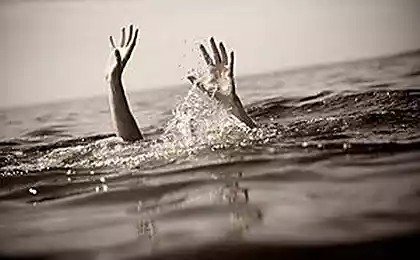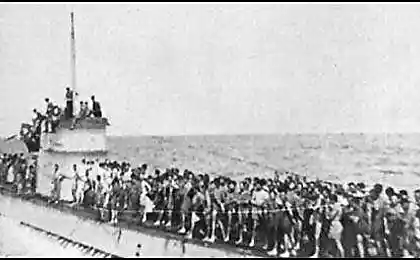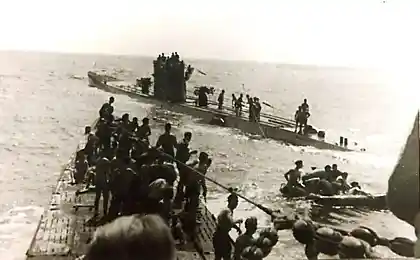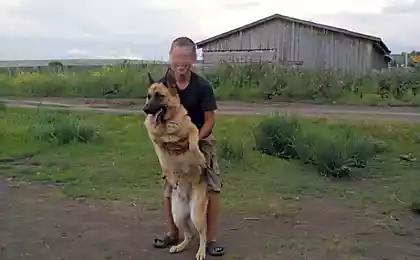437
Be careful on the water! Buried rarely similar to drowning
When drown children, the adults usually are close and do not realize that the child dies.
The new captain jumped from the bridge, being fully clothed, and swam. As a former lifeguard, he kept his eyes on the victim, going directly to a pair of tourists, floating between the boat, anchored, and the beach. "I think he thinks you're drowning," he addressed the man to his wife. They played in the water, brizgys each other, and she from time to time screamed but now they were just standing on a sandbank in the neck in the water. "We have everything in order, what does he do?" she asked with some irritation. "We are all right!" — cried the husband, waving a hand to the rescuer, but the captain did not bother to stop. "Way!" he shouted, passing between the stunned boat owners. Right behind them, just three metres from his father, were drowning their nine-year-old daughter. When the captain pulled her out of the water, she cried: "Daddy!"

As captain, being 15 metres from the rest, understood what he could not understand father, being only three meters away from the drowning girl? When a person is drowning, he doesn't give a sharp and piercing cry for help, according to most people. The captain was trained to recognize drowning professionals and years of experience. On the other hand, the father has gathered information about how looks like a man drowning, of television programs. If you spend time on the water or on the shore (and from time to time all do), you should make sure that you and the people around you know how you can determine that a person is drowning, even before entering the water. Before the girl with tears cried out "Daddy!", she made no sound. As a former coast guard rescue swimmer, I wasn't surprised by this story. When a person is drowning, it is rarely accompanied by any sounds. Waving hands, splashes and screams, which prepares us TV, there are in real life very rarely.

"The instinctive reaction of a drowning man" (Instinctive Drowning Response), so named by Dr. Francesco Pia (Francesco A. Pia), this is what people do to avoid actual or perceived suffocation when immersed in water. And it looks quite different, as most people think. No waving hands, splashes and screams for help. To better understand how quiet and nutralise this process looks like from the shore, think about this: among children under 15 years of age drowning is the second most common cause of death (after traffic accidents), and of the approximately 750 children who will drown next year, every second person will drown at a distance of not more than 20 meters from their parents or other adults. In some cases, even adult will directly observe how a child is drowning, not knowing about what is really going on. Buried rarely similar to drowning, and in his article in the journal On the Scene, owned by the coast guard, Dr. Pia describes the instinctive drowning response as follows:
1. "Except in rare cases, drowning people are physiologically unable to call for help. The respiratory system is designed for breathing. It is its secondary function. Before it will be possible, it is necessary to restore respiratory function.
2. Mouth drowning person alternately goes under the water and emerges above the surface. Mouth drowning person is above water long enough to enable them to exhale, inhale and call for help. When a drowning man emerges from the water, his lack of time, only to quickly exhale and inhale, and then he immediately goes back under the water.
3. Drowning people cannot wave their arms to attract attention. They instinctively hold out my hands to the side in an attempt to push off from water. Such movements allow them to float to the surface, to be able to breathe.
4. Instinctive reactions of drowning people cannot control the hand movements. People trying to stay on the surface of water, physiologically not able to stop sinking and to make meaningful movement – waving arms, to try to approach the rescue or access to rescue equipment.
5. From the beginning to the end, until the action is instinctive reaction, the body of a drowning person remains in a vertical position, without the slightest sign of supporting movements of the legs. If the trained rescuer will not pull it out of the water, the drowning man can hold on to the surface from 20 to 60 seconds before completely under water.
This does not mean that the person calling for help and desperately waving his arms, cheating you – it's probably a panic attack in the water. Such an attack is not always preceded by an instinctive reaction of a drowning man, and often lasts not long, but unlike drowning victims of such panic on the water can help their rescuers – for example, grab a lifeline.
When you are on shore or in the water, you need to pay close attention to the following signs that a person is drowning:
• The victim's head submerged in water, and the mouth is near to the surface;
• Head thrown back, mouth open;
• Glass, empty eyes are not focused;
• The victim's eyes are closed.
• Hair covers the forehead or eyes;
• The victim is kept in water in vertical position without making movements of the legs;
• The victim is breathing and often superficial, captures breath;
• Trying to swim in a certain direction, but to no avail;
• Trying to roll over on his back;
• It may seem that the victim is climbing the ladder.
Therefore, if a person falls overboard and everything looks fine, don't get complacent ahead of time. Sometimes the most important sign that a person is drowning is that he doesn't look like drowning. It may seem that he's just trying to stay afloat and looking at the deck. How to determine if all is in order? Ask a simple question: "are you all right?" If the person you at least said something, then maybe he is not in danger. If the answer to your question you will see a blank stare, you only have half a minute to pull the victim out of the water. And, parents, remember: children playing in water make noise. If they stopped making noise, remove them from the water and find out why. published
P. S. And remember, only by changing their consumption — together we change the world! ©
Source: vk.com/vk.goodfakts
The new captain jumped from the bridge, being fully clothed, and swam. As a former lifeguard, he kept his eyes on the victim, going directly to a pair of tourists, floating between the boat, anchored, and the beach. "I think he thinks you're drowning," he addressed the man to his wife. They played in the water, brizgys each other, and she from time to time screamed but now they were just standing on a sandbank in the neck in the water. "We have everything in order, what does he do?" she asked with some irritation. "We are all right!" — cried the husband, waving a hand to the rescuer, but the captain did not bother to stop. "Way!" he shouted, passing between the stunned boat owners. Right behind them, just three metres from his father, were drowning their nine-year-old daughter. When the captain pulled her out of the water, she cried: "Daddy!"

As captain, being 15 metres from the rest, understood what he could not understand father, being only three meters away from the drowning girl? When a person is drowning, he doesn't give a sharp and piercing cry for help, according to most people. The captain was trained to recognize drowning professionals and years of experience. On the other hand, the father has gathered information about how looks like a man drowning, of television programs. If you spend time on the water or on the shore (and from time to time all do), you should make sure that you and the people around you know how you can determine that a person is drowning, even before entering the water. Before the girl with tears cried out "Daddy!", she made no sound. As a former coast guard rescue swimmer, I wasn't surprised by this story. When a person is drowning, it is rarely accompanied by any sounds. Waving hands, splashes and screams, which prepares us TV, there are in real life very rarely.

"The instinctive reaction of a drowning man" (Instinctive Drowning Response), so named by Dr. Francesco Pia (Francesco A. Pia), this is what people do to avoid actual or perceived suffocation when immersed in water. And it looks quite different, as most people think. No waving hands, splashes and screams for help. To better understand how quiet and nutralise this process looks like from the shore, think about this: among children under 15 years of age drowning is the second most common cause of death (after traffic accidents), and of the approximately 750 children who will drown next year, every second person will drown at a distance of not more than 20 meters from their parents or other adults. In some cases, even adult will directly observe how a child is drowning, not knowing about what is really going on. Buried rarely similar to drowning, and in his article in the journal On the Scene, owned by the coast guard, Dr. Pia describes the instinctive drowning response as follows:
1. "Except in rare cases, drowning people are physiologically unable to call for help. The respiratory system is designed for breathing. It is its secondary function. Before it will be possible, it is necessary to restore respiratory function.
2. Mouth drowning person alternately goes under the water and emerges above the surface. Mouth drowning person is above water long enough to enable them to exhale, inhale and call for help. When a drowning man emerges from the water, his lack of time, only to quickly exhale and inhale, and then he immediately goes back under the water.
3. Drowning people cannot wave their arms to attract attention. They instinctively hold out my hands to the side in an attempt to push off from water. Such movements allow them to float to the surface, to be able to breathe.
4. Instinctive reactions of drowning people cannot control the hand movements. People trying to stay on the surface of water, physiologically not able to stop sinking and to make meaningful movement – waving arms, to try to approach the rescue or access to rescue equipment.
5. From the beginning to the end, until the action is instinctive reaction, the body of a drowning person remains in a vertical position, without the slightest sign of supporting movements of the legs. If the trained rescuer will not pull it out of the water, the drowning man can hold on to the surface from 20 to 60 seconds before completely under water.
This does not mean that the person calling for help and desperately waving his arms, cheating you – it's probably a panic attack in the water. Such an attack is not always preceded by an instinctive reaction of a drowning man, and often lasts not long, but unlike drowning victims of such panic on the water can help their rescuers – for example, grab a lifeline.
When you are on shore or in the water, you need to pay close attention to the following signs that a person is drowning:
• The victim's head submerged in water, and the mouth is near to the surface;
• Head thrown back, mouth open;
• Glass, empty eyes are not focused;
• The victim's eyes are closed.
• Hair covers the forehead or eyes;
• The victim is kept in water in vertical position without making movements of the legs;
• The victim is breathing and often superficial, captures breath;
• Trying to swim in a certain direction, but to no avail;
• Trying to roll over on his back;
• It may seem that the victim is climbing the ladder.
Therefore, if a person falls overboard and everything looks fine, don't get complacent ahead of time. Sometimes the most important sign that a person is drowning is that he doesn't look like drowning. It may seem that he's just trying to stay afloat and looking at the deck. How to determine if all is in order? Ask a simple question: "are you all right?" If the person you at least said something, then maybe he is not in danger. If the answer to your question you will see a blank stare, you only have half a minute to pull the victim out of the water. And, parents, remember: children playing in water make noise. If they stopped making noise, remove them from the water and find out why. published
P. S. And remember, only by changing their consumption — together we change the world! ©
Source: vk.com/vk.goodfakts























